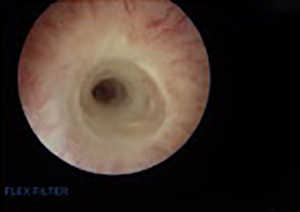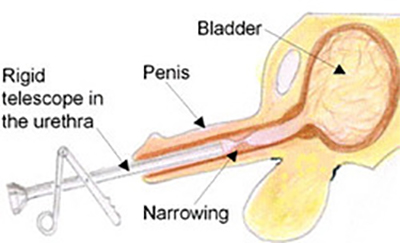
What is a Direct Vision Internal Urethrotomy?
A Direct Vision Internal Urethrotomy, also called a DVIU, is a procedure for the treatment of urethral strictures. Urethral strictures are a narrowing of the urethral that can cause difficulty with urination and changes with ejaculation. While women can develop urethral stricture, DVIU is only appropriate for treatment of male urethral strictures.
Why might I need a Direct Vision Internal Urethrotomy?
If you have a urethral stricture (scar tissue narrowing the urethra) that has not been previously treated, you can consider a DVIU as a treatment option. This procedure is straightforward and frequently effective. DVIUs can be helped with injection of local medications that slow or prevent scar recurrence.

Preparing for your Direct Vision Internal Urethrotomy:
In general, preparation for a DVIU will involve the following steps:
- You may have bloodwork and other testing done at the hospital
- The hospital will call you to confirm arrival time and instructions
- You will be asked if you have allergies to medications, anesthesia, or latex.
- You should inform your doctor of any medications, vitamins, or supplements that you are taking.
- You should refrain from taking anti-inflammatories or blood-thinning medications a week prior to the procedure. Any blood thinning medications will be discussed with you and your doctors
- It is also important to inform your doctor if you are pregnant or might be pregnant, diabetic, asthmatic, or have any other medical conditions.
- You may be asked to refrain from eating 8 hours prior to your scheduled arrival time and drinking 2 hours prior to your arrival time.
- You should remove all metal objects and accessories such as eyeglasses, jewelry, watch, etc. as they can interfere with the imaging technique used.
- You should arrange for someone to drive you home after the procedure.
What happens during a Direct Vision Internal Urethrotomy?
A DVIU is a surgical procedure that requires some amount of anesthesia. Your anesthesiologist will discuss with you how they will make for comfortable during the procedure. In general, the procedure occurs as follows:
- You receive anesthesia
- You are positioned with your legs up to allow access with a camera to your urethra
- A contrast liquid is injected into your urethra and an Xray is taken to show exactly where the stricture is
- A rigid camera is inserted into the urethra and the stricture is seen
- Using a cutting instrument the stricture is opened
- Your surgeon may inject a medication into the scar to reduce recurrence
- A catheter is placed to divert urine around the healing area
- You wake up in the recovery room.
What can I expect after my Procedure?
Patients will usually have a urinary catheter for 2-3 days following this procedure. The purpose of the catheter is to allow urine to pass around the area of the scar. It is common to see a small amount of blood in your urine. The surgery does not cause very much discomfort.
After removal of the catheter, you should have immediate improvement of the urine stream. This is usually greatest in the period immediately after the surgery and may change to a slightly slower stream over time.
Your doctor will monitor your urine stream over time, usually several times in the first 6 months then less frequently if your stream remains stable.
What are the risk of Procedure?
Urinary tract infection and blood in the urine are the most common short terms risks of this procedure. Long term, the risk of stricture recurrence is around 30-40%. This is a high rate, but the simplicity of the surgery makes it appropriate for men to initially try. Men who have stricture recurrence will likely need a more advanced procedure, called a urethroplasty.
